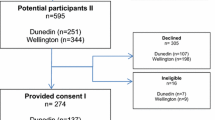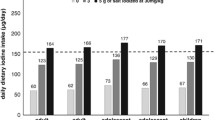Abstract
Purpose
We assessed the effect of the current iodine fortification level (20 µg/g household salt and salt included in bread and bakery products) on inadequate and excessive intake in the general Danish population. Intake models with/without the contribution from food supplements and effects of excluding specific food groups were evaluated.
Method
Data from the Danish National Survey of Dietary Habits and Physical Activity in 2011–13 (N = 3946, aged 4–75 years) stratified by age-group and sex were used to estimate habitual dietary iodine intakes, and compared with established dietary reference values.
Results
The proportion with an estimated inadequate iodine intake was ≤ 3% for males and ≤ 5% for females, except for 15–17-year-old girls, where the probable prevalence of an inadequate intake was 11%. Including the contribution from food supplements gave similar results (10%). High intakes (as defined by 95th percentile) from food sources generally did not exceed the tolerable upper intake level (UL). However, for the youngest age-groups (4–6-year-old boys/girls and 7–10-year-old boys), the 95th percentiles exceeded the UL with 11%, 4% and 7%, respectively, when food supplements were included in the estimates. Especially exclusion of dairy products and bread led to an inadequate intake for both boys and girls.
Conclusion
The current fortification level may provide an inadequate iodine intake for some females and on the other hand lead to excessive intakes in the youngest age-groups. The study shows the importance of choosing iodine-rich alternatives when excluding major sources of iodine in the Danish diet.
Similar content being viewed by others
Availability of data
Data from this paper can be made available upon request to the corresponding author.
Code availability
Code for this analysis can be available upon request to the corresponding author.
References
Widmaier EP, Raff H, Strang KT, Vander A (2011) Vander’s human physiology: the mechanisms of body function (The Endocrine System), 12th edn. McGraw-Hill, McGraw-Hill Education, New York
EFSA (2002) Opinion of the Scientific Committee on Food on the Tolerable Upper Intake Level of Iodine. Sci Comm Food Sci Panel Diet Prod Nutr Allerg. https://doi.org/10.2903/j.efsa.2004.60
NNR (2014) Nordic Nutrition Recommendations 2012—integrating nutrition and physical activity, 5th edn. Nordic Council of Ministers
Zimmermann MB, Jooste PL, Pandav CS (2008) Iodine-deficiency disorders. Lancet 372:1251–1262
Knudsen N, Bulow I, Jorgensen T et al (2000) Comparative study of thyroid function and types of thyroid dysfunction in two areas in Denmark with slightly different iodine status. Eur J Endocrinol 143:485–491. https://doi.org/10.1530/eje.0.1430485
Laurberg P, Pedersen IB, Carlé A, Andersen S, Knudsen N, Ovesen LRL (2009) Chapter 47—the U-shaped curve of iodine intake and thyroid disorders. In: Victor R et al (eds) Comprehensive handbook of iodine. Academic Press, Cambridge
WHO—World Health Organization (2001) Assessment of iodine deficiency disorders and monitoring their elimination: a guide for programme managers, 2nd ed. World Heal Organ, pp 1–124
National Food Institute, Technical University of Denmark (2000) Note: food directorate order no. 627 of 29/06/2000
Rasmussen LB, Ovesen L, Bülow I et al (2002) Dietary iodine intake and urinary iodine excretion in a Danish population: effect of geography, supplements and food choice. Br J Nutr 87:61–69. https://doi.org/10.1079/bjn2001474
Rasmussen LB, Andersson G, Haraldsdóttir J et al (1996) Iodine. Do we need an enrichment program in Denmark? Int J Food Sci Nutr 47:377–381. https://doi.org/10.3109/09637489609006950
Laurberg P, Perrild H, Jørgensen T, Ovesen L, Rasmussen LB (2009) Fødevareberigelse med jod: Den danske monitorering (DanThyr). Natl Food Institute, Tech Univ Denmark 1:1–34
Bjergved L, Jørgensen T, Perrild H et al (2012) Predictors of change in serum TSH after iodine fortification: an 11-year follow-up to the DanThyr study. J Clin Endocrinol Metab 97:4022–4029. https://doi.org/10.1210/jc.2012-2508
Krejbjerg A, Bjergved L, Pedersen IB et al (2014) Iodine fortification may influence the age-related change in thyroid volume: a longitudinal population-based study (DanThyr). Eur J Endocrinol 170:507–517. https://doi.org/10.1530/EJE-13-0918
Krejbjerg A, Bjergved L, Pedersen IB et al (2015) Serum thyroglobulin before and after iodization of salt: an 11-year DanThyr follow-up study. Eur J Endocrinol 173:573–581. https://doi.org/10.1530/EJE-15-0339
Krejbjerg A, Bjergved L, Pedersen IB et al (2014) Thyroid nodules in an 11-year DanThyr follow-up study. J Clin Endocrinol Metab 99:4749–4757. https://doi.org/10.1210/jc.2014-2438
Laurberg P, Jørgensen T, Perrild H et al (2006) The Danish investigation on iodine intake and thyroid disease, DanThyr: status and perspectives. Eur J Endocrinol 155:219–228. https://doi.org/10.1530/eje.1.02210
Laurberg P, Pedersen KM, Hreidarsson A et al (1998) Iodine intake and the pattern of thyroid disorders: a comparative epidemiological study of thyroid abnormalities in the elderly in iceland and in Jutland, Denmark. J Clin Endocrinol Metab 83:765–769. https://doi.org/10.1210/jcem.83.3.4624
Rasmussen LB, Carlé A, Jørgensen T et al (2008) Iodine intake before and after mandatory iodization in Denmark: results from the Danish investigation of iodine intake and thyroid diseases (DanThyr) study. Br J Nutr 100:166–173. https://doi.org/10.1017/S0007114507886387
Rasmussen LB, Jørgensen T, Perrild H et al (2014) Mandatory iodine fortification of bread and salt increases iodine excretion in adults in Denmark—a 11-year follow-up study. Clin Nutr 33:1033–1040. https://doi.org/10.1016/j.clnu.2013.10.024
Andersen SL, Sørensen LK, Krejbjerg A et al (2013) Iodine deficiency in Danish pregnant women. Dan Med J 60:A4657
Kirkegaard-Klitbo DM, Perslev K, Andersen SL, Perrild H, Knudsen N, Weber T, Rasmussen LB, Laurberg P (2016) Iodine deficiency in pregnancy is prevalent in vulnerable groups in Denmark. Dan Med J 63:A5286
Miljø og Fødevareministeriet (2019) Bekendtgørelse om tilsætning af jod til husholdningssalt og salt i brød og almindeligt bagværk m.v .nr 613 af 28/5 2019. j.nr 2019-29-31-00009
Pedersen AN, Christensen T, Matthiessen J et al (2015) Dietary Habits in Denmark 2011–2013. In Main results [In Danish: Danskernes Kostvaner 2011–2013: Hovedresultater]. Natl Food Institute, Tech Univ Denmark, pp 1–208
Nordman M, Matthiessen J, Biltoft-Jensen A et al (2020) Weekly variation in diet and physical activity among 4–75-year-old Danes. Public Health Nutr 23:1350–1361. https://doi.org/10.1017/S1368980019003707
Food data (frida.fooddata.dk) version 4 (2019) Natl Food Institute, Tech Univ Denmark
Bysted A, Trolle E, Jakobsen J (2021) Nutrient content in dairy products 2010–2012. DTU Food Natl Food Inst, Tech Univ Denmark, pp 1–72
Miljø og Fødevareministeriet (2016) Bekendtgørelse om kosttilskud. BEK nr 39 af 12/01/2016. j.nr 2016-27-31-00193
Institute of Medicine of the National Academies (2000) DRI dietary reference intakes: applications in dietary assessment. The National Academy of Sciences, Washington, DC
Institute of Medicine of the National Academies (2006) Dietary reference intakes: the essential guide to nutrient requirements. The National Academy of Sciences, Washington, DC
Medin AC, Carlsen MH, Andersen LF (2020) Iodine intake among children and adolescents in Norway: estimates from the national dietary survey Ungkost 3 (2015–2016). J Trace Elem Med Biol. https://doi.org/10.1016/j.jtemb.2019.126427
Vanderpump MPJ, Lazarus JH, Smyth PP et al (2011) Iodine status of UK schoolgirls: a cross-sectional survey. Lancet 377:2007–2012. https://doi.org/10.1016/S0140-6736(11)60693-4
Rasmussen LB, Kirkegaard-Klitbo DM, Laurberg T, Jorgensen L, Ovesen L, Perrild H (2016) Iodine excretion in school children in Copenhagen. Dan Med J 63
Verkaik-Kloosterman J, Buurma-Rethans EJM, Dekkers ALM, Van Rossum CTM (2017) Decreased, but still sufficient, iodine intake of children and adults in the Netherlands. Br J Nutr 117:1020–1031. https://doi.org/10.1017/S0007114517000733
Friberg AKH, Jørgensen FS (2015) Few danish pregnant women follow guidelines on periconceptional use of folic acid. Dan Med J 62:A5019
Esche J, Thamm M, Remer T (2020) Contribution of iodized salt to total iodine and total salt intake in Germany. Eur J Nutr 59:3163–3169. https://doi.org/10.1007/s00394-019-02154-7
Crawford BA, Cowell CT, Emder PJ et al (2010) Iodine toxicity from soy milk and seaweed ingestion is associated with serious thyroid dysfunction. Med J Aust 193:413–415. https://doi.org/10.5694/j.1326-5377.2010.tb03972.x
Dawczynski C, Schäfer U, Leiterer M, Jahreis G (2007) Nutritional and toxicological importance of macro, trace, and ultra-trace elements in algae food products. J Agric Food Chem 55:10470–10475. https://doi.org/10.1021/jf0721500
Miyai K, Tokushige T, Kondo M et al (2008) Suppression of thyroid function during ingestion of seaweed “Kombu” (Laminaria japonoca) in normal Japanese adults. Endocr J 55:1103–1108. https://doi.org/10.1507/endocrj.K08E-125
Knudsen V (2014) Danskernes forbrug af kosttilskud. Natl Food Institute, Tech Univ Denmark
Knudsen VK, Orozova-Bekkevold I, Rasmussen LB et al (2004) Low compliance with recommendations on folic acid use in relation to pregnancy: is there a need for fortification? Public Health Nutr 7:843–850. https://doi.org/10.1079/phn2004630
Zimmerman MB (2007) Key barriers to global iodine deficiency disorder control: a summary. A2Z technical brief. http://www.a2zproject.org/pdf/Gap-Analysis-Iodine-Final.pdf
Dineva M, Rayman MP, Bath SC (2021) Iodine status of consumers of milk-alternative drinks v. cows’ milk: data from the UK national diet and nutrition survey. Br J Nutr 126:28–36. https://doi.org/10.1017/S0007114520003876
Tonacchera M, Dimida A, De Servi M et al (2013) Iodine fortification of vegetables improves human iodine nutrition: in vivo evidence for a new model of iodine prophylaxis. J Clin Endocrinol Metab. https://doi.org/10.1210/jc.2012-3509
Lawson PG, Daum D, Czauderna R et al (2015) Soil versus foliar iodine fertilization as a biofortification strategy for field-grown vegetables. Front Plant Sci 6:1–11. https://doi.org/10.3389/fpls.2015.00450
Weng HX, Liu HP, Li DW et al (2014) An innovative approach for iodine supplementation using iodine-rich phytogenic food. Environ Geochem Health 36:815–828
WHO, UNICEF, ICCIDD (2007) Assessment of iodine deficiency disorders and monitoring their elimination: a guide for programme managers, 3rd edn. World Health Organization, Geneva, pp 1–98
EFSA (2014) Guidance on the EU menu methodology. EFSA J 12:3944, 80 pp. https://doi.org/10.2903/j.efsa.2014.3944
Biltoft-Jensen A, Matthiessen J, Rasmussen LB et al (2009) Validation of the Danish 7-day pre-coded food diary among adults: energy intake v. energy expenditure and recording length. Br J Nutr 102:1838–1846. https://doi.org/10.1017/S0007114509991292
Johansen AMW, Myhre JB, Hjartåker A, Andersen LF (2019) Validation of energy intake recorded by a 7-day pre-coded food diary against measured energy expenditure in a group of Norwegian adults. PLoS ONE. https://doi.org/10.1371/JOURNAL.PONE.0215638
Tam KW, Veerman JL (2019) Prevalence and characteristics of energy intake under-reporting among Australian adults in 1995 and 2011 to 2012. Nutr Diet 76:546–559. https://doi.org/10.1111/1747-0080.12565
Berta Vanrullen I, Volatier JL, Bertaut A et al (2014) Characteristics of energy intake under-reporting in French adults. Br J Nutr 111:1292–1302. https://doi.org/10.1017/S0007114513003759
Lioret S, Touvier M, Balin M et al (2011) Characteristics of energy under-reporting in children and adolescents. Br J Nutr 105:1671–1680. https://doi.org/10.1017/S0007114510005465
de Lauzon B, Volatier J, Martin A (2004) A Monte Carlo simulation to validate the EAR cut-point method for assessing the prevalence of nutrient inadequacy at the population level. Public Health Nutr 7:893–900. https://doi.org/10.1079/phn2004616
Murphy SP, Barr SI (2011) Practice paper of the American Dietetic Association: using the dietary reference intakes. J Am Diet Assoc 111:762–770. https://doi.org/10.1016/j.jada.2011.03.022
Funding
This study was partly financed by the Ministry of Food, Agriculture and Fisheries of Denmark.
Author information
Authors and Affiliations
Contributions
GRH and CEL designed the study. TC, MO and CEL analyzed the data. GRH, ET, and MO interpreted the data. MO and CEL wrote the first draft of the paper. All authors contributed to the manuscript and have read and approved the final version of the manuscript.
Corresponding author
Ethics declarations
Conflict of interest
The authors declare that they have no conflict of interest.
Ethics approval
The Danish National Surveys on Diet and Physical Activity have been conducted in accordance with the guidelines laid down in the Declaration of Helsinki and have been approved by the Danish Data Protection Agency. The Danish National Committee on Health Research Ethics has decided that, according to Danish Law, the studies do not require their approval.
Consent to participate
Verbal informed consent was obtained from all subjects.
Rights and permissions
About this article
Cite this article
Outzen, M., Lund, C.E., Christensen, T. et al. Assessment of iodine fortification of salt in the Danish population. Eur J Nutr 61, 2939–2951 (2022). https://doi.org/10.1007/s00394-022-02826-x
Received:
Accepted:
Published:
Issue Date:
DOI: https://doi.org/10.1007/s00394-022-02826-x




